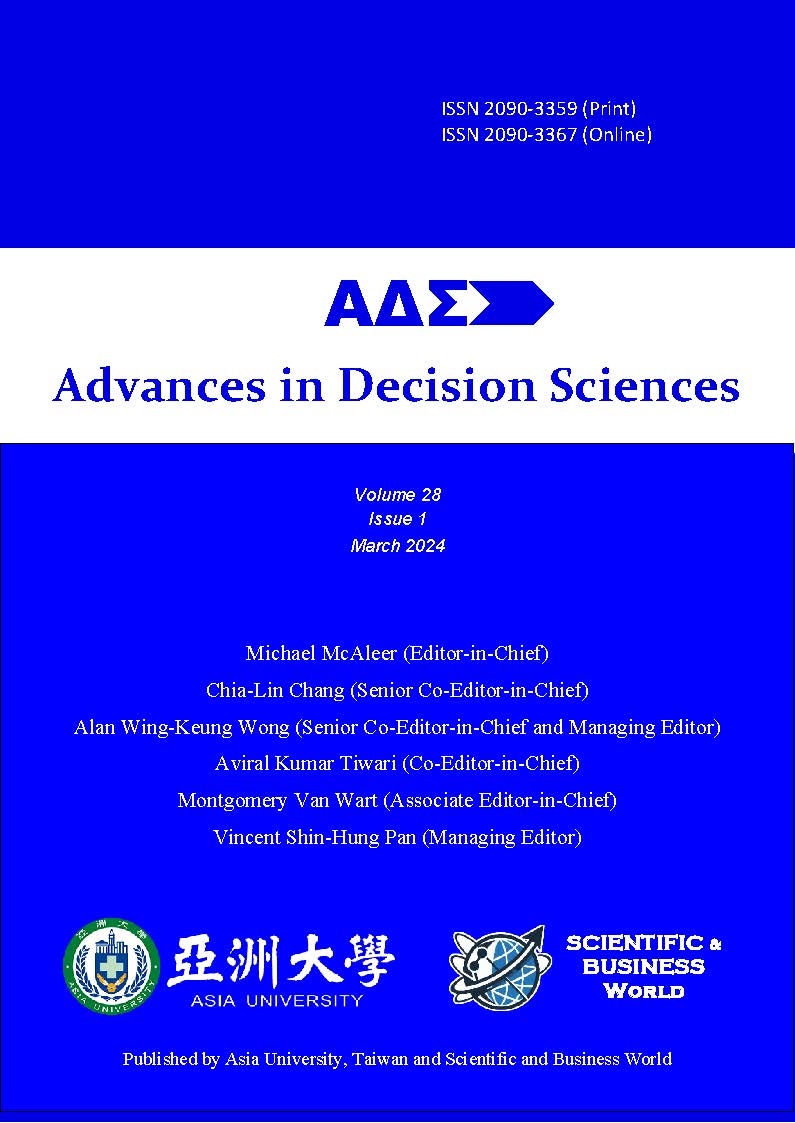A CRITIC-I-TOPSIS Approach to Assess Public Satisfaction with Cultural Services in Urban Communities
DOI:
https://doi.org/10.47654/v28y2024i1p96-121Keywords:
Urban Community Public Cultural Services, Satisfaction Evaluation, CRITIC, TOPSIS-SortAbstract
Purpose: This paper aims to propose a multi-criteria evaluation method for assessing public cultural service quality satisfaction in urban communities. The method is validated by evaluating satisfaction with public cultural service quality in the Baihe Yuan community of Nanan District, Chongqing, China. The study also explores the factors influencing public cultural service quality satisfaction in this community. Evaluating satisfaction with public cultural service quality requires assessment across multiple dimensions, making it a classic multi-criteria decision-making problem.
Design/methodology/approach: In the evaluation process, we utilized the CRITIC method to determine the weights of influencing factors and the I-TOPSIS-Sort method to assess the factors affecting public cultural service quality satisfaction in this area. Among them, I-TOPSIS-Sort is a multi-criteria sorting method improved in this study.
Findings: The research findings indicate that the factor of greatest concern to residents of Baiheyuan Community in Nan'an District is "Equipment for Community Cultural Services," while the least concerning indicator is "Personnel of Community Public Cultural Services." Furthermore, in terms of evaluation ratings, all indicators for this community were classified as C, except for "Personnel of Community Public Cultural Services," which was categorized as D. This suggests that residents of the community are generally satisfied with the quality of public cultural services. However, there is still room for improvement in the quality of public cultural services in the community.
Practical Implication: This study focuses on Baiheyuan Community in Nan'an District as the research subject and improves the CRITIC and I-TOPSIS-Sort methods to evaluate the satisfaction level of public cultural service quality in the community. This research is beneficial for assisting policymakers and decision-makers in assessing the quality of public cultural services, thereby aiding them in policy formulation and decision-making. Ultimately, it aims to further refine management systems and better meet the public cultural service needs of residents.
Originality/value: This paper evaluates public cultural service quality satisfaction in urban communities using the CRITIC-I-TOPSIS-Sort method to address the contradictions between the increasing public cultural demands and the original supply. Among them, CRITIC-I-TOPSIS-Sort is the multi-criteria sorting framework proposed in this study.
References
Akram, M., Ramzan, N., & Deveci, M. (2023). Linguistic Pythagorean fuzzy CRITIC-EDAS method for multiple-attribute group decision analysis. Engineering Applications of Artificial Intelligence, 119, 105777. https://doi.org/10.1016/j.engappai.2022.105777
Bera, T., & Mahapatra, N. K. (2024). Selection of waste water treatment plans alternative: a neutrosophy based MCDM approach OPSEARCH, 61, 524–547. https://doi.org/10.1007/s12597-023-00708-2
Black, A. (2011). ‘We don’t do public libraries like we used to’: attitudes to public library buildings in the UK at the start of the 21st century. Journal of Librarianship Information Sciences, 43(1), 30-45. https://doi.org/10.1177/0961000610390991
Cai, W., & Liu, Y. (2022). The Value of Immersive Media in Expanding Chinese Public Cultural Participation and Its Realization Path From the Perspective of Cultural Education. Front Psychol, 13, 915913. https://doi.org/10.3389/fpsyg.2022.915913
Faraji Sabokbar, H., Hosseini, A., Banaitis, A., & Banaitiene, N. (2016). A novel sorting method TOPSIS-Sort: An application for tehran environmental quality evaluation. E+M Ekonomie a Management, 19(2), 87-104. https://doi.org/10.15240/tul/001/2016-2-006
Hendiani, S., & Walther, G. (2023). TOPSISort-L: An extended likelihood-based interval-valued intuitionistic fuzzy TOPSIS-sort method and its application to multi-criteria group decision-making. Expert Systems with Applications, 233, 121005. https://doi.org/https://doi.org/10.1016/j.eswa.2023.121005
Hu, Z., & Xu, X. (2021). How accurate is the supply of public cultural services in urban communities: the perspective of social enterprises? Journal of the Party School of the Central Committee of the C.P.C.(Chinese Academy of Governance), 25(06), 103-110. https://doi.org/10.14119/j.cnki.zgxb.2021.06.010
Ime, I. M., Shuaibu, M. S., Dixit, S., Obong, L. B., & Bala, B. B. (2022). The effects of overcrowding on students living in university of Calabar Female Hostel, Cross River State, Nigeria. Journal Healthcare Treatment Development(24), 8-27. https://doi.org/10.55529/jhtd24.8.27
Irfan, M., Elavarasan, R. M., Ahmad, M., Mohsin, M., Dagar, V., & Hao, Y. (2022). Prioritizing and overcoming biomass energy barriers: Application of AHP and G-TOPSIS approaches. Technological Forecasting and Social Change, 177. https://doi.org/10.1016/j.techfore.2022.121524
Kelly, J. M., & Swindell, D. (2002). A multiple–indicator approach to municipal service evaluation: Correlating performance measurement and citizen satisfaction across jurisdictions. Public Administration Review, 62(5), 610-621. https://doi.org/10.1111/1540-6210.00241
Khan, A. A., Mashat, D. S., & Dong, K. (2024). Evaluating sustainable urban development strategies through spherical CRITIC-WASPAS analysis. Journal of Urban Development and Management, 3(1), 1-17. https://doi.org/10.56578/judm030101
Li, R. Y. M., Chau, K. W., & Zeng, F. F. (2019). Ranking of Risks for Existing and New Building Works. Sustainability, 11(10), 2863. https://doi.org/10.3390/su11102863
Li, W., Ren, X., He, Q., Xu, D., & Dong, L. (2023). Sustainability assessment of power generation systems under the objective consideration of criteria interactions. Journal of Cleaner Production, 395, 136423. https://doi.org/10.1016/j.jclepro.2023.136423
Mandal, S., Gazi, K. H., Salahshour, S., Mondal, S. P., Bhattacharya, P., & Saha, A. K. (2024). Application of Interval Valued Intuitionistic Fuzzy Uncertain MCDM Methodology for Ph.D Supervisor Selection Problem. Results in Control and Optimization, 15, 100411. https://doi.org/10.1016/j.rico.2024.100411
Noh, Y. (2012). A study measuring the performance of electronic resources in academic libraries. Aslib proceedings, https://doi.org/10.1108/00012531211215169
Rong, L., & Wang, X. (2022). A study on matching supply and demand of public cultural services in urban communities in Wuchang district, Wuhan City, China PR Magazine(17), 83-85. https://doi.org/10.16645/j.cnki.cn11-5281/c.2022.17.041
Shahid, T., Ashraf, S., & Mashat, D. S. (2023). Enhancing urban development with picture fuzzy sets: A strategic decision support framework. Journal of Urban Development and Management, 2(4), 172-180. https://doi.org/10.56578/judm020401
Shi, X., Holahan, P. J., & Jurkat, M. P. (2004). Satisfaction formation processes in library users: understanding multisource effects. The Journal of Academic Librarianship, 30(2), 122-131. https://doi.org/10.1016/j.acalib.2004.01.002
Su, J., Wang, D., Xu, B., Zhang, F., & Zhang, N. (2024). An interval-valued intuitionistic fuzzy group decision-making method for evaluating online knowledge payment products. Applied Soft Computing, 150(111046). https://doi.org/https://doi.org/10.1016/j.asoc.2023.111046
Sun, C., Tan, G., Chai, X., & Zhang, H. (2023). Analysis on the Satisfaction of Public Cultural Service by Township Residents: A Qualitative Perspective. Sustainability, 15(9), 7302. https://doi.org/10.3390/su15097302
Sun, Y. (2022). Study on the optimization path of public cultural services in chongqing street community in changchun city [master's degree, Party School of the Jilin Provincial Committee of the Communist Party of China (Jilin Provincial School of Administration)]. https://doi.org/10.27474/d.cnki.gzjld.2022.000038
Sun, Y., & Shi, Y. (2023). Evaluation of public cultural service quality in harbin based on SPSS software Proceedings of the 2nd International Conference on Public Management and Big Data Analysis, https://doi.org/10.5220/0012070100003624
Tešić, D., Božanić, D., & Khalilzadeh, M. (2024). Enhancing multi-criteria decision-making with fuzzy logic: An advanced defining interrelationships between ranked ii method incorporating triangular fuzzy numbers. Journal of Intelligent Management Decision, 3(1), 56-67. https://doi.org/10.56578/jimd030105
Wang, P., Fu, Y., Liu, P., Zhu, B., Wang, F., & Pamucar, D. (2024). Evaluation of ecological governance in the Yellow River basin based on Uninorm combination weight and MULTIMOORA-Borda method. Expert Systems with Applications, 235, 121227. https://doi.org/https://doi.org/10.1016/j.eswa.2023.121227
Wang, X., Chan, H. K., & Li, D. (2015). A case study of an integrated fuzzy methodology for green product development. European Journal of Operational Research, 241(1), 212-223. https://doi.org/10.1016/j.ejor.2014.08.007
Wanyan, D., & Wang, Z. (2022). Why low-income people have difficulty accessing to obtain public cultural services? Evidence from an empirical study on representative small and medium-sized cities. Library Hi Tech, 40(5), 1244-1266. https://doi.org/10.1108/LHT-02-2021-0055
Wei, Q. (2021). Sustainability evaluation of photovoltaic poverty alleviation projects using an integrated MCDM method: A case study in Guangxi, China. Journal of Cleaner Production, 302, 127040. https://doi.org/10.1016/j.jclepro.2021.127040
Wu, H.-W., Zhen, J., & Zhang, J. (2020). Urban rail transit operation safety evaluation based on an improved CRITIC method and cloud model. Journal of Rail Transport Planning & Management, 16, 100206. https://doi.org/10.1016/j.jrtpm.2020.100206
Xie, Z., Zhang, Y., & Fang, Z. (2022). The Space–Time Evolution of the Coupling and Coordinated Development of Public Cultural Services and Cultural Industries: A Case Study of 31 Regions in China. Sustainability, 14(22), 15463. https://doi.org/10.3390/su142215463
Xiong, Y., & Zhou, Y. (2021). Resident participation in community-based public cultural services: the dual drivers of public service quality and motivation Library Development, 3, 34-45. https://doi.org/10.19764/j.cnki.tsgjs.20201912
Yang, G., & Hua, X. (2018). Endogenous supply mechanism and effectiveness of public cultural services in urban communities: A practical analysis based on Wuhan Community S's "Lelingju" Journal of Social Work, 3, 98-108+112.
Yang, Z., Xia, M., Wan, X., Wang, M., & Tang, W. (2024). Artificial intelligence technology enabling innovation in museum public cultural service models. Applied Mathematics and Nonlinear Sciences, 9(1). https://doi.org/10.2478/amns.2023.2.01661
Yatsalo, B., Radaev, A., Haktanir, E., Skulimowski, A. M. J., & Kahraman, C. (2024). A family of fuzzy multi-criteria sorting models FTOPSIS-Sort: Features, case study analysis, and the statistics of distinctions. Expert Systems with Applications, 237. https://doi.org/10.1016/j.eswa.2023.121486

Published
Issue
Section
License
Copyright (c) 2024 Advances in Decision Sciences

This work is licensed under a Creative Commons Attribution-NonCommercial 4.0 International License.



 Scientific and Business World
Scientific and Business World